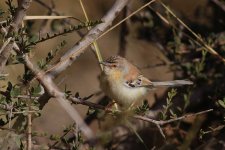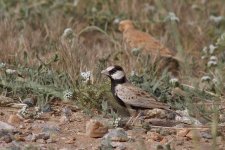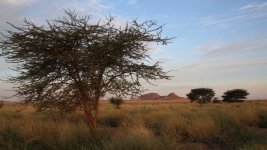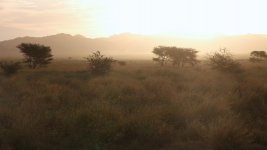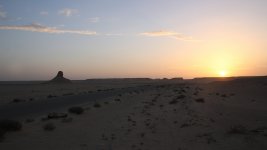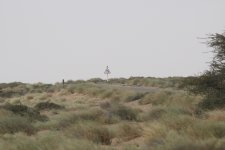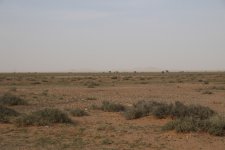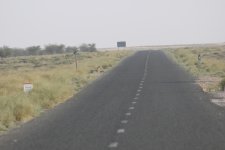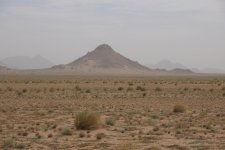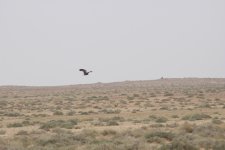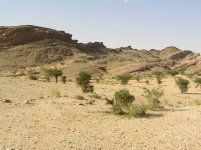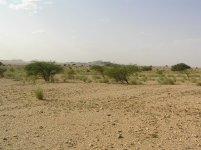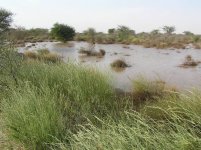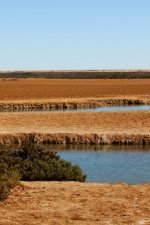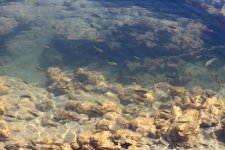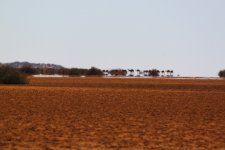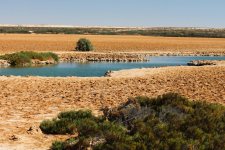opisska
rabid twitcher

Do you remember that feeling you got when you were packing your gear after a cold morning in Nizzana? The desire to get more of what you just experienced, the sudden love for the sparse desert greenery? That, my friend, is the call of Aousserd. And the time to listen to it is now, before it is too late.
Based on some good advice received on this forum, we went for two birding weeks in Morocco over Christmas and New Year, focus on Western Sahara, but picking up some Moroccan staples along the way. There are many detailed reports online, so I will just present some information that I find interesting.
To note before reading:
- We are the worst birdwatchers to ever grace this hobby. Thus, our results are the bare minimum that you are supposed to see at any place.
- The best way to read the report is with the proper soundtrack - https://youtu.be/N4ebZvq94sg
Information sources:
- Finding Birds in Morocco by Dave Gosney: two tiny books you really need to have, one for coast and mountains (a) and one for the desserts (b)
- a large selection of reports is linked by people in my topic here: http://www.birdforum.net/showthread.php?t=336120. From those, I particularly liked the Poelstra report https://www.cloudbirders.com/tripreport/repository/POELSTRA_Morocco_0405_2015.pdf, mainly because of the insanely practical list of GPS points.
I will use references in the form "Gosney LetterPage:site" and "Poelstra GPSpoint" extensively in the part on specific birds.
Highlights and comments:
- 150 species (including a brief stop in Malaga), 26 lifers in 15 days in winter. Pretty cool. Nothing groundbreaking though.
- Western Sahara (WS) a rather nice place to go, the Aousserd road is the African dream come true - Oued Jenna is awesome even without mentioning the birds.
- About half of the WS targets scored: Black-crowned Sparrow-larks in large flocks, Cricket Longtails at every Wadi, a pair of Dunn's Larks after a daunting search. No Sudan Golden Sparrows, Golden Nightjars, Royal Terns, or Kelp Gulls.
- Most of general Moroccan specialties found. Notable exceptions: Spotted Sandgrouse, African Desert Warbler, Dupont's Lark and the mountain species which we didn't go for. Also Thick-billed Larks only seen from car in WS.
- I was a little disappointed with the sites in Morocco proper: most of the Gosney sites just aren't very attractive places to go; in particular the coastal sites are often in the middle of highly inhabited areas and some places have a serious rubbish problem. Maybe the season contributed as some places were pretty dead, probably due to the cold - the nights we spent near Tata, the Tagdlit track and Zeida were deeply freezing.
Random practical advice:
- Western Sahara seems pretty safe, besides the landmines that are really hard to judge. We walked around the Aousserd road freely, but in other places, we stuck to roads.
- As everyone else says, get the "la fiche" papers (google it and take the form you like the most), fill them in (what you can at home and the rest later) in like 10 copies per person and handle them out liberally at WS checkpoints.
- Know how to deal with checkpoints: the "stop" sign usually is round and small, just thrown by the road with variable Arabic/French/Spanish signs, a couple of dozen meters before the policemen - or even across a roundabout from them. Unless you want to be fined, stop right there, no matter what other drivers do and wait to be waived (by torchlight in night), then stop again next to the policeman. Do not feel pressured by other drivers behind you, the controls must be respected.
- You can get around without any real French knowledge whatsoever. Always have a town in mind ahead of you where you "are going" and if you don't understand the questions, just name the town. Know how to call your profession in French; if you are a journalist, make up another profession and say that. Hide your lenses and binos before a checkpoint.
- With the exception of the first night in Nador and the penultimate one in Mezourga (to take a shower), we always camped. Only near Merja Zerga we took an official campsite, as the area is pretty developed, the rest was wild camping. In Dakhla we actually tried to get a hotel or camping, but everything was either ugly, closed or overpriced. Once (along the road back from WS, near Boujdour), we got a visit from a soldier telling us that he is guarding a nearby post and he doesn't really like us camping here, but we can stay anyway.
- Camping in the desert is a little different from what you might now - be prepared to anchor the tent solely on stones, as the ground is useless. We always found enough stones, only at the Zeida site, we had to collect them from a large area using the car in freight mode
- We took the boat to Melilla, crossed to Nador and then rented a car. This is a viable way - contrary to all the newspaper articles about "migration", the Melilla border was calm and easy. The only reasonable rental is at Nador airport, a little out of the way, but no problem to get to. Dealing with AirCar was smooth and the car was good.
- As we already knew from Jordan, Dacia Logan is great for some mild offroading thanks to the high clearance. The biggest enemy of a 2x2 car in desert is sand, so around the Aousserd road, the possibilities are limited, but in the Merzouga area, there are places where you can really go straight through the desert.
- The only weird thing about the Logan was the fuel tank - we initially thought that either the meter is broken or the readings at the petrol stations are rigged, but later we concluded that the skill of pump operators in WS is simply beyond belief - they can squeeze 20 liters extra into the 50 liter tank! With the diesel Logan taking only 5 liters per 100 km, this means an insane range of 1400 km that we did not test - but the Aousserd road was definitely not an issue (moreover, the petrol station in Aousserd is working).
- The traffic is surprisingly tame for an Arab country, people aren't overly aggressive. Sadly, they are overly stupid - people will stop anytime and anywhere because they just feel like it, change lanes for no reason on an empty highway, or just do whatever else they randomly decide they'd like to do. The disregard of Moroccan drivers for any other form of life but themselves is simply staggering and you need to keep this fact at every second you spend behind the wheel!
- Some cities are an non-signposted maze of streets with no clear way out, even if you have planned to just follow a "major throughfare". As usual, we got the relevant tiles from http://garmin.openstreetmap.nl/ to use in OruxMaps on my Android and it helped a lot. We also purchased the ITMB map Morocco 1:1.2 million, which is complete rubbish - in particular in WS, many roads are completely misplaced, including the Aousserd one! In southern Morocco proper, it fails to portray for example the N12 road between Foum Zgoud and Tazzarine, making navigation in the area a complete mess.
The following remarks aren't meant to be anyhow exhaustive. Just the more interesting bits, hopefully.
Birds and places - Western Sahara:
- Khnifiss Lagoon is quite cool, with lots of birds to watch from the cliff. Surprisingly, on both visits, the heat haze was non-existent and very distant birds could be seen - I regretted not having a more powerful eyepiece with me. The second visit however was tarnished by very strong winds, forcing sand into everything and making observations harder. Despite the beauty of the area, we have not only failed to see the Kelp Gulls, but any GBBG-type gulls at all. The huge amount of LBBGs makes the search quite daunting.
- We have spent two mornings at Gleb Jidane (Poelstra 17A). We saw Crowned Sandgrouse at both occassions but the second morning we knew better and positioned our car/hide to see not the pool below the tower, but the outflow towards the road and we saw them much better. A lot of Temminck's larks came drinking as well.
- The first hundred kms of the Aousserd road don't give much hope (and it was a blasting sandstorm), but it gets better quickly and it's really, really good.
- We saw the first Cricket Longtails in a random wadi at 22.957 N 14.777 Z; later we have seen them many times in and around Oued Jenna.
- The first big flock of Desert Sparrows appeared at km 36 (from Aousserd), some more were on the outskirts of Aousserd itself. We vigorously searched the flocks for Sudan Goldens, but no luck.
- Black-crowned Sparrow-larks were somehow the most common bird around the road in the vicinity of Oued Jenna, with large flocks gathering in the grass and sometimes on the tarmac. Their 1st year birds present a significant obstacle in finding Dunn's Larks, because they look very similar.
- We have looked for Dunn's Larks at many places, checking all the Poelstra "no Dunn's Lark" sites until finally finding them at - I think - 18D, a couple hundred meters from the road. One of the hardest fights I have ever put up for a species honestly.
- Other interesting species from the area: Fulvous Babblers in some acacia areas, Hoopoe Larks numerous, Bar-tailed Larks common, but not as much as other people report, Cream-colored Cousers mostly near (but not in) Oued Jenna, Stone-Curlews north of the road in Oued Jenna, Spectacled Warblers rather common on Acacia trees, Great Spotted Cuckoo at Poelstra 18A.
- Inspired by the reports, we tried to "spotlight", not really knowing how to do it. We found what we think is Lesser Egyptian Jerboa and something else slightly different, some bats, a hedgehog and my wife might have glimpsed a fennec - definitely no Nightjars though. We also tried to look for Desert Warbler at some site from a report, but no luck.
- Many of the side tracks from the main road can be followed with a Logan, but usually not very far. The track at the western site of Oued Jenna that goes south is really good and allows exploration of large parts of the wadi (and nice camping). Going anywhere beyond Aousserd is forbidden by the police.
- We have spent half a day looking for Royal Terns around Dakhla but with no luck. There were big flocks of Caspian Terns with chances of very close observations and one Lesser Crested Tern found north of Dakhla where the road goes near the bay side of the peninsula. The most impressive place was at the very southern tip near Lassarga, where on low tide, there were thousands congregating in the tidal zone.
- We have made an "exploratory trip" to the south. We have reached the border with Mauritania in Guerguerat without issues, but nothing much is there, just a couple of houses, some interesting African vibes and a couple of common birds. Walking around in any direction is definitely forbidden and the road leading there from the north is clearly signed with minefield warnings. The biggest reward for the journey was a group of Thick-billed Larks flying over flying over this road. On the way back, we took a side track that looked well trodden, but nothing of interest was there, the same can be said about a fishing village near Bir Gandouz. The road is signed to Laguera, which looks interesting on the map, but it is off-limits.
- On the way back, we turned east to Imlili, where some interesting lagoons are supposed to be. There is even advertisement for them by the road, claiming some suspiciously small distance. After this distance, the tarmac ends, but the lagoons aren't there. The road can be followed for a bit further, but the sand eventually blocks it for a 2x2 car. Near the end of the tarmac, we have at least found a pair of Maghreb Wheatears.
- Two Lanner Falcons - one on the peninsula road short before Dakhla, one somewhere between Oued Chebka and Tantan beach on the electric pole. Other than that, there were many birds on the poles, invariably Long-legged Buzzards.
Birds and places - Morocco proper:
- The ferry between Malaga and Melilla gave us distant views of two Balearic Shearwaters
- Marsh Owl in Merdja Zerga: we found the way to Poelstra 8C easily (despite the report saying we need a guide for that) and there we were quickly captured by a local man, who turned out to be a self-proclaimed owl guide. He spoke no practical language, but seemed used to it and was able to communicate well regardless. We didn't really want a guide, but he kinda attached himself to us and eventually took us to the right spots (a couple of hundred meters south of Poelstra 8D), so we gave him 100 MAD for which he seemed grateful. First we saw one owl short after sunset far above the reeds, but then at least two came into the pastures (despite significant human presence) and flew pretty close to us, giving great views. Also a Little Owl was calling nearby.
- Red-cobbed Coots were seen only at Merdja Khaloufa, Gosney A4:2, a couple of individuals in a huge Eurasian Coot flock. They are surprisingly easy to ID, the best mark is the blueish color of the shield that really stands out.
- Larache March is an example of a terrible site with great birds - the track through it gets heavy lorry traffic because of some construction. At Gosney A2:4, there was a single obvious dry area where we could be a couple of meters from the road. There we played the Moustached Warbler song, which oddly attracted a very showy Cetti's Warbler and only then a Moustached Warbler appeared, also showing well in the reeds.
- Double-spurred Francolins in Sidi Yahya - we have visited essentially every Gosney and Poelastra place in the evening and the following morning, but no sighting of a Francolin. However we heard them well, with the best place on a track that turns right a couple hundred meters along the track perpendicular to the road at Gosney A36:5; we met some locals there and they were not protesting our presence. We were however told to leave from Gosney A36:2. Also note that the road to the "parking" (A36:3) has been blocked and you can't go there by car (we camped a couple of kilometers away for that reason). The Gosney "getting there" description is confusing, better to use a GPS and a map (the most direct road is different).
- Marbled duck we found only on the "lovely pools" in Oualidia (Gosney A10:3), from distance but in huge numbers. The nearby "campsite pools" are quite nice, but an even better place is A10:4, where huge quantities of Audouin's Gulls and waders were found.
- Brown-throated Sand Martins in Essaouira: the colony was empty, but we eventually saw one or two birds flying around at sunset.
- Tamri has welcomed us with an annoying "wannabe guide", but we escaped and found a flock of Bald Ibises from the main road a couple of kilometers north of the village after some driving around. We suck at seawatching, so the two probably Shearwaters seen from Cap Rhir will remain unidentified, but the military installment there was the only place where we saw House Buntings. Beware that it is forbidden to photograph the military building (which we did, because the buntings were on it and then we lied to the military about it).
- Black-crowned Tchagras: seen at Sidi Yahya, near Cap Rhir and some more places, for us surprisingly easy to see.
- Moussier’s Redstarts also very easy at sea level, in Essaouira, Oued Massa and more.
- The Tissint drinking site (Poelstra 19E) produced several flocks of Crowned Sandgrouse and an epic amount of Trumpeter Finches on top of being and extremely attractive place to see.
- In Foum Zguid, the palm groves close to the "secret" (according to our map) crossroads bewteen R111 and N12 had Fulvous Babblers, the only such occurence in Morocco proper.
- We went to Mhamid to try for the Pied Crow, but the palm area around it is huge - and visiting there is a rather discouraging experience, because the amount of touts is otherworldly; they don't even hesitate to jump in front of your car in order to stop you and try to sell you their services. Like I am ever going to buy something from you when you are so annoying, dumbass ...
- As the road back from Mhamid leaves the palms and turns north, it crosses some dunes with a lot of bushes. This turned out to be a good site for Tristram's warblers (but we saw many of those also around Merzouga as well).
- The Tagdlit track was pretty dead, but in nearby Gorges du Dades, we found a pair of Bonneli's Eagles after some half an our of sitting by the road at 31.531 N 5.924 W. The road then continues to the mountains, but was blocked by ice and snow eventually. The detour at least produced Barbary Partridge and Rock Buntings.
- The dunes of Erg Chebi in Merzouga are spectacular and worth visiting on their own, even though the "Auberge area" around Jasmina has been turned into a small town already. Sadly, almost all water bodies described in Gosney in the area were completely dry, barring some small pools near to Auberge Jasmina that had some Ruddy Shelducks, and no sandgrouse were found anywhere. We have searched each and every Desert Warbler site in the area we had information about, but with no luck; we also tried for Egyptian Nightjars, because from our Czech version of Svensson it is not clear whether they are resident or migratory, but (correctly ) with no results. The road from Erfoud to Merzouga is now tarmac all the way (but not in the same line as the original track), making travelling around the area very easy.
) with no results. The road from Erfoud to Merzouga is now tarmac all the way (but not in the same line as the original track), making travelling around the area very easy.
Based on some good advice received on this forum, we went for two birding weeks in Morocco over Christmas and New Year, focus on Western Sahara, but picking up some Moroccan staples along the way. There are many detailed reports online, so I will just present some information that I find interesting.
To note before reading:
- We are the worst birdwatchers to ever grace this hobby. Thus, our results are the bare minimum that you are supposed to see at any place.
- The best way to read the report is with the proper soundtrack - https://youtu.be/N4ebZvq94sg
Information sources:
- Finding Birds in Morocco by Dave Gosney: two tiny books you really need to have, one for coast and mountains (a) and one for the desserts (b)
- a large selection of reports is linked by people in my topic here: http://www.birdforum.net/showthread.php?t=336120. From those, I particularly liked the Poelstra report https://www.cloudbirders.com/tripreport/repository/POELSTRA_Morocco_0405_2015.pdf, mainly because of the insanely practical list of GPS points.
I will use references in the form "Gosney LetterPage:site" and "Poelstra GPSpoint" extensively in the part on specific birds.
Highlights and comments:
- 150 species (including a brief stop in Malaga), 26 lifers in 15 days in winter. Pretty cool. Nothing groundbreaking though.
- Western Sahara (WS) a rather nice place to go, the Aousserd road is the African dream come true - Oued Jenna is awesome even without mentioning the birds.
- About half of the WS targets scored: Black-crowned Sparrow-larks in large flocks, Cricket Longtails at every Wadi, a pair of Dunn's Larks after a daunting search. No Sudan Golden Sparrows, Golden Nightjars, Royal Terns, or Kelp Gulls.
- Most of general Moroccan specialties found. Notable exceptions: Spotted Sandgrouse, African Desert Warbler, Dupont's Lark and the mountain species which we didn't go for. Also Thick-billed Larks only seen from car in WS.
- I was a little disappointed with the sites in Morocco proper: most of the Gosney sites just aren't very attractive places to go; in particular the coastal sites are often in the middle of highly inhabited areas and some places have a serious rubbish problem. Maybe the season contributed as some places were pretty dead, probably due to the cold - the nights we spent near Tata, the Tagdlit track and Zeida were deeply freezing.
Random practical advice:
- Western Sahara seems pretty safe, besides the landmines that are really hard to judge. We walked around the Aousserd road freely, but in other places, we stuck to roads.
- As everyone else says, get the "la fiche" papers (google it and take the form you like the most), fill them in (what you can at home and the rest later) in like 10 copies per person and handle them out liberally at WS checkpoints.
- Know how to deal with checkpoints: the "stop" sign usually is round and small, just thrown by the road with variable Arabic/French/Spanish signs, a couple of dozen meters before the policemen - or even across a roundabout from them. Unless you want to be fined, stop right there, no matter what other drivers do and wait to be waived (by torchlight in night), then stop again next to the policeman. Do not feel pressured by other drivers behind you, the controls must be respected.
- You can get around without any real French knowledge whatsoever. Always have a town in mind ahead of you where you "are going" and if you don't understand the questions, just name the town. Know how to call your profession in French; if you are a journalist, make up another profession and say that. Hide your lenses and binos before a checkpoint.
- With the exception of the first night in Nador and the penultimate one in Mezourga (to take a shower), we always camped. Only near Merja Zerga we took an official campsite, as the area is pretty developed, the rest was wild camping. In Dakhla we actually tried to get a hotel or camping, but everything was either ugly, closed or overpriced. Once (along the road back from WS, near Boujdour), we got a visit from a soldier telling us that he is guarding a nearby post and he doesn't really like us camping here, but we can stay anyway.
- Camping in the desert is a little different from what you might now - be prepared to anchor the tent solely on stones, as the ground is useless. We always found enough stones, only at the Zeida site, we had to collect them from a large area using the car in freight mode
- We took the boat to Melilla, crossed to Nador and then rented a car. This is a viable way - contrary to all the newspaper articles about "migration", the Melilla border was calm and easy. The only reasonable rental is at Nador airport, a little out of the way, but no problem to get to. Dealing with AirCar was smooth and the car was good.
- As we already knew from Jordan, Dacia Logan is great for some mild offroading thanks to the high clearance. The biggest enemy of a 2x2 car in desert is sand, so around the Aousserd road, the possibilities are limited, but in the Merzouga area, there are places where you can really go straight through the desert.
- The only weird thing about the Logan was the fuel tank - we initially thought that either the meter is broken or the readings at the petrol stations are rigged, but later we concluded that the skill of pump operators in WS is simply beyond belief - they can squeeze 20 liters extra into the 50 liter tank! With the diesel Logan taking only 5 liters per 100 km, this means an insane range of 1400 km that we did not test - but the Aousserd road was definitely not an issue (moreover, the petrol station in Aousserd is working).
- The traffic is surprisingly tame for an Arab country, people aren't overly aggressive. Sadly, they are overly stupid - people will stop anytime and anywhere because they just feel like it, change lanes for no reason on an empty highway, or just do whatever else they randomly decide they'd like to do. The disregard of Moroccan drivers for any other form of life but themselves is simply staggering and you need to keep this fact at every second you spend behind the wheel!
- Some cities are an non-signposted maze of streets with no clear way out, even if you have planned to just follow a "major throughfare". As usual, we got the relevant tiles from http://garmin.openstreetmap.nl/ to use in OruxMaps on my Android and it helped a lot. We also purchased the ITMB map Morocco 1:1.2 million, which is complete rubbish - in particular in WS, many roads are completely misplaced, including the Aousserd one! In southern Morocco proper, it fails to portray for example the N12 road between Foum Zgoud and Tazzarine, making navigation in the area a complete mess.
The following remarks aren't meant to be anyhow exhaustive. Just the more interesting bits, hopefully.
Birds and places - Western Sahara:
- Khnifiss Lagoon is quite cool, with lots of birds to watch from the cliff. Surprisingly, on both visits, the heat haze was non-existent and very distant birds could be seen - I regretted not having a more powerful eyepiece with me. The second visit however was tarnished by very strong winds, forcing sand into everything and making observations harder. Despite the beauty of the area, we have not only failed to see the Kelp Gulls, but any GBBG-type gulls at all. The huge amount of LBBGs makes the search quite daunting.
- We have spent two mornings at Gleb Jidane (Poelstra 17A). We saw Crowned Sandgrouse at both occassions but the second morning we knew better and positioned our car/hide to see not the pool below the tower, but the outflow towards the road and we saw them much better. A lot of Temminck's larks came drinking as well.
- The first hundred kms of the Aousserd road don't give much hope (and it was a blasting sandstorm), but it gets better quickly and it's really, really good.
- We saw the first Cricket Longtails in a random wadi at 22.957 N 14.777 Z; later we have seen them many times in and around Oued Jenna.
- The first big flock of Desert Sparrows appeared at km 36 (from Aousserd), some more were on the outskirts of Aousserd itself. We vigorously searched the flocks for Sudan Goldens, but no luck.
- Black-crowned Sparrow-larks were somehow the most common bird around the road in the vicinity of Oued Jenna, with large flocks gathering in the grass and sometimes on the tarmac. Their 1st year birds present a significant obstacle in finding Dunn's Larks, because they look very similar.
- We have looked for Dunn's Larks at many places, checking all the Poelstra "no Dunn's Lark" sites until finally finding them at - I think - 18D, a couple hundred meters from the road. One of the hardest fights I have ever put up for a species honestly.
- Other interesting species from the area: Fulvous Babblers in some acacia areas, Hoopoe Larks numerous, Bar-tailed Larks common, but not as much as other people report, Cream-colored Cousers mostly near (but not in) Oued Jenna, Stone-Curlews north of the road in Oued Jenna, Spectacled Warblers rather common on Acacia trees, Great Spotted Cuckoo at Poelstra 18A.
- Inspired by the reports, we tried to "spotlight", not really knowing how to do it. We found what we think is Lesser Egyptian Jerboa and something else slightly different, some bats, a hedgehog and my wife might have glimpsed a fennec - definitely no Nightjars though. We also tried to look for Desert Warbler at some site from a report, but no luck.
- Many of the side tracks from the main road can be followed with a Logan, but usually not very far. The track at the western site of Oued Jenna that goes south is really good and allows exploration of large parts of the wadi (and nice camping). Going anywhere beyond Aousserd is forbidden by the police.
- We have spent half a day looking for Royal Terns around Dakhla but with no luck. There were big flocks of Caspian Terns with chances of very close observations and one Lesser Crested Tern found north of Dakhla where the road goes near the bay side of the peninsula. The most impressive place was at the very southern tip near Lassarga, where on low tide, there were thousands congregating in the tidal zone.
- We have made an "exploratory trip" to the south. We have reached the border with Mauritania in Guerguerat without issues, but nothing much is there, just a couple of houses, some interesting African vibes and a couple of common birds. Walking around in any direction is definitely forbidden and the road leading there from the north is clearly signed with minefield warnings. The biggest reward for the journey was a group of Thick-billed Larks flying over flying over this road. On the way back, we took a side track that looked well trodden, but nothing of interest was there, the same can be said about a fishing village near Bir Gandouz. The road is signed to Laguera, which looks interesting on the map, but it is off-limits.
- On the way back, we turned east to Imlili, where some interesting lagoons are supposed to be. There is even advertisement for them by the road, claiming some suspiciously small distance. After this distance, the tarmac ends, but the lagoons aren't there. The road can be followed for a bit further, but the sand eventually blocks it for a 2x2 car. Near the end of the tarmac, we have at least found a pair of Maghreb Wheatears.
- Two Lanner Falcons - one on the peninsula road short before Dakhla, one somewhere between Oued Chebka and Tantan beach on the electric pole. Other than that, there were many birds on the poles, invariably Long-legged Buzzards.
Birds and places - Morocco proper:
- The ferry between Malaga and Melilla gave us distant views of two Balearic Shearwaters
- Marsh Owl in Merdja Zerga: we found the way to Poelstra 8C easily (despite the report saying we need a guide for that) and there we were quickly captured by a local man, who turned out to be a self-proclaimed owl guide. He spoke no practical language, but seemed used to it and was able to communicate well regardless. We didn't really want a guide, but he kinda attached himself to us and eventually took us to the right spots (a couple of hundred meters south of Poelstra 8D), so we gave him 100 MAD for which he seemed grateful. First we saw one owl short after sunset far above the reeds, but then at least two came into the pastures (despite significant human presence) and flew pretty close to us, giving great views. Also a Little Owl was calling nearby.
- Red-cobbed Coots were seen only at Merdja Khaloufa, Gosney A4:2, a couple of individuals in a huge Eurasian Coot flock. They are surprisingly easy to ID, the best mark is the blueish color of the shield that really stands out.
- Larache March is an example of a terrible site with great birds - the track through it gets heavy lorry traffic because of some construction. At Gosney A2:4, there was a single obvious dry area where we could be a couple of meters from the road. There we played the Moustached Warbler song, which oddly attracted a very showy Cetti's Warbler and only then a Moustached Warbler appeared, also showing well in the reeds.
- Double-spurred Francolins in Sidi Yahya - we have visited essentially every Gosney and Poelastra place in the evening and the following morning, but no sighting of a Francolin. However we heard them well, with the best place on a track that turns right a couple hundred meters along the track perpendicular to the road at Gosney A36:5; we met some locals there and they were not protesting our presence. We were however told to leave from Gosney A36:2. Also note that the road to the "parking" (A36:3) has been blocked and you can't go there by car (we camped a couple of kilometers away for that reason). The Gosney "getting there" description is confusing, better to use a GPS and a map (the most direct road is different).
- Marbled duck we found only on the "lovely pools" in Oualidia (Gosney A10:3), from distance but in huge numbers. The nearby "campsite pools" are quite nice, but an even better place is A10:4, where huge quantities of Audouin's Gulls and waders were found.
- Brown-throated Sand Martins in Essaouira: the colony was empty, but we eventually saw one or two birds flying around at sunset.
- Tamri has welcomed us with an annoying "wannabe guide", but we escaped and found a flock of Bald Ibises from the main road a couple of kilometers north of the village after some driving around. We suck at seawatching, so the two probably Shearwaters seen from Cap Rhir will remain unidentified, but the military installment there was the only place where we saw House Buntings. Beware that it is forbidden to photograph the military building (which we did, because the buntings were on it and then we lied to the military about it).
- Black-crowned Tchagras: seen at Sidi Yahya, near Cap Rhir and some more places, for us surprisingly easy to see.
- Moussier’s Redstarts also very easy at sea level, in Essaouira, Oued Massa and more.
- The Tissint drinking site (Poelstra 19E) produced several flocks of Crowned Sandgrouse and an epic amount of Trumpeter Finches on top of being and extremely attractive place to see.
- In Foum Zguid, the palm groves close to the "secret" (according to our map) crossroads bewteen R111 and N12 had Fulvous Babblers, the only such occurence in Morocco proper.
- We went to Mhamid to try for the Pied Crow, but the palm area around it is huge - and visiting there is a rather discouraging experience, because the amount of touts is otherworldly; they don't even hesitate to jump in front of your car in order to stop you and try to sell you their services. Like I am ever going to buy something from you when you are so annoying, dumbass ...
- As the road back from Mhamid leaves the palms and turns north, it crosses some dunes with a lot of bushes. This turned out to be a good site for Tristram's warblers (but we saw many of those also around Merzouga as well).
- The Tagdlit track was pretty dead, but in nearby Gorges du Dades, we found a pair of Bonneli's Eagles after some half an our of sitting by the road at 31.531 N 5.924 W. The road then continues to the mountains, but was blocked by ice and snow eventually. The detour at least produced Barbary Partridge and Rock Buntings.
- The dunes of Erg Chebi in Merzouga are spectacular and worth visiting on their own, even though the "Auberge area" around Jasmina has been turned into a small town already. Sadly, almost all water bodies described in Gosney in the area were completely dry, barring some small pools near to Auberge Jasmina that had some Ruddy Shelducks, and no sandgrouse were found anywhere. We have searched each and every Desert Warbler site in the area we had information about, but with no luck; we also tried for Egyptian Nightjars, because from our Czech version of Svensson it is not clear whether they are resident or migratory, but (correctly
Attachments
Last edited:




